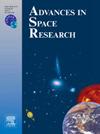验证基于NeQuick模型、集合卡尔曼滤波器和SMART+的上层电离层和等离子体估算结果
IF 2.8
3区 地球科学
Q2 ASTRONOMY & ASTROPHYSICS
引用次数: 0
摘要
在这项工作中,我们分析了集合卡尔曼滤波器(EnKF)方法、同步乘法柱归一化方法 SMART+ 和 NeQuick 模型的性能,以估算顶部电离层和等离子体。11 颗低地球轨道(LEO)卫星的斜面总电子含量(STEC)测量结果被用作 EnKF 和 SMART+ 的输入,以更新作为背景模型的 NeQuick 模型。本文章由计算机程序翻译,如有差异,请以英文原文为准。
Validation of the NeQuick model, Ensemble Kalman filter and SMART+ based estimations of the topside ionosphere and plasmasphere
In this work, we analyse the performance of an Ensemble Kalman filter (EnKF) approach, the simultaneous multiplicative column normalized method SMART+ and the NeQuick model to estimate the topside ionosphere and plasmasphere. The slant total electron content (STEC) measurements of 11 Low Earth Orbit (LEO) satellites are used as input for the EnKF and SMART+ to update the NeQuick model which serves as background model.
Our comparative case study is implemented globally for altitudes between 430 and 20 200 km for two periods of the year 2015 covering moderate to perturbed ionospheric conditions.
The performance of the methods is investigated regarding their capability to reproduce electron densities. For that purpose, the independent electron density measurements of the Van Allen Probes (VAP) twin satellites, Swarm Langmuir Probes (LP) and FORMOSAT-3/COSMIC ionospheric radio occultation (IRO) profiles serve as reference.
The results reveal that in median the NeQuick model underestimates the IRO electron densities in the moderate period and for high latitudes in the perturbed period. For the NeQuick model the median of the absolute relative residuals is about 33 % in the moderate period and around 25 % in the perturbed period. SMART+ reduces these residuals to about 24 % and 23 %, respectively, whereas EnKF doesn’t provide an improvement.
The validation with VAP electron densities shows that in both periods and for all altitudes, the electron densities provided by the NeQuick model, the EnKF and SMART+ are in general significantly lower than the VAP measurements with a median of the relative residuals equal to about 80 %. The lowest median and RMS values of the VAP residuals are produces by EnKF, reducing the NeQuick statistics by up to 9 %.
Further we observe that the electron densities provided by the NeQuick model are in median lower than the calibrated LP in-situ measurements for all three Swarm satellites in the moderate period and higher in the perturbed period. SMART+ shows the lowest median and standard deviation for the absolute relative residuals. These are up to 20 % lower than for the NeQuick model. For the LP in-situ measurements, the EnKF has the worst performance.
Overall, the results underpin that even though the data of 11 satellite missions has been assimilated to adjust the a priori information of the NeQuick model, only limited improvements can be achieved especially for the plasmasphere.
求助全文
通过发布文献求助,成功后即可免费获取论文全文。
去求助
来源期刊

Advances in Space Research
地学天文-地球科学综合
CiteScore
5.20
自引率
11.50%
发文量
800
审稿时长
5.8 months
期刊介绍:
The COSPAR publication Advances in Space Research (ASR) is an open journal covering all areas of space research including: space studies of the Earth''s surface, meteorology, climate, the Earth-Moon system, planets and small bodies of the solar system, upper atmospheres, ionospheres and magnetospheres of the Earth and planets including reference atmospheres, space plasmas in the solar system, astrophysics from space, materials sciences in space, fundamental physics in space, space debris, space weather, Earth observations of space phenomena, etc.
NB: Please note that manuscripts related to life sciences as related to space are no more accepted for submission to Advances in Space Research. Such manuscripts should now be submitted to the new COSPAR Journal Life Sciences in Space Research (LSSR).
All submissions are reviewed by two scientists in the field. COSPAR is an interdisciplinary scientific organization concerned with the progress of space research on an international scale. Operating under the rules of ICSU, COSPAR ignores political considerations and considers all questions solely from the scientific viewpoint.
 求助内容:
求助内容: 应助结果提醒方式:
应助结果提醒方式:


